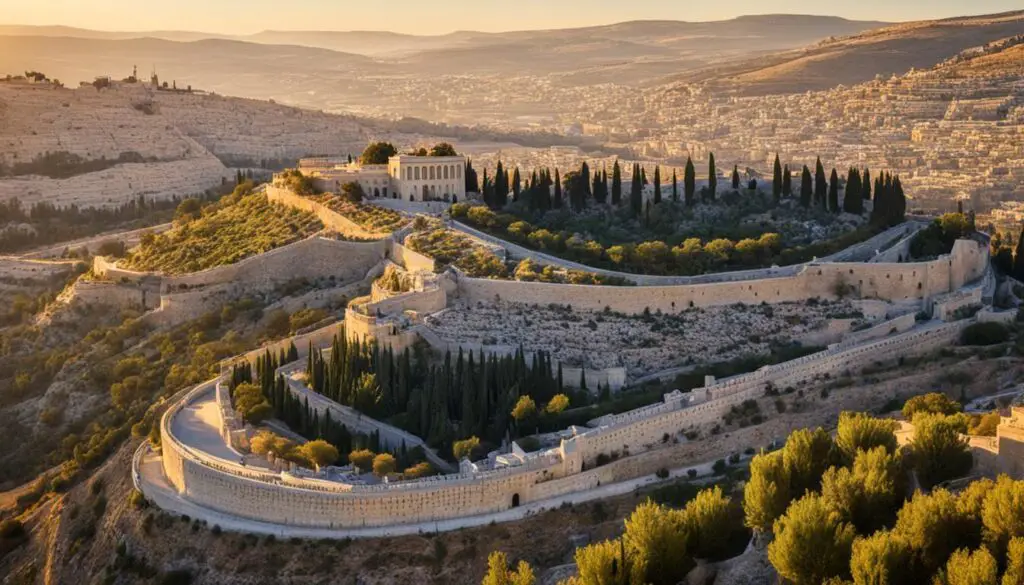The New Testament is not just a collection of religious teachings and stories; it is also a window into a rich tapestry of ancient geographical settings. These New Testament places are not merely words on a page, but they represent biblical sites that hold deep historical and spiritual significance. Exploring these holy places and sacred locations allows us to step into the footsteps of Jesus and his early followers, connecting us to the roots of our Christianity in a profound and tangible way.
Key Takeaways:
- The New Testament is filled with significant biblical cities and historic biblical sites that play a crucial role in the Christian faith.
- Exploring these New Testament places provides a deeper understanding of the events and teachings of Jesus and the early Christians.
- These locations hold spiritual and historical value, making them popular ancient pilgrimage sites for believers.
- By immersing ourselves in the geographical context of the New Testament, we can enrich our faith and gain a fresh perspective on scripture.
- These religious landmarks serve as powerful reminders of the enduring legacy of the New Testament.
The Geography of the Four Gospels and Acts of the Apostles
The New Testament contains four canonical Gospels – Matthew, Mark, Luke, and John – along with the Acts of the Apostles. Together, they provide a vivid portrayal of the life, teachings, and ministry of Jesus Christ, as well as the subsequent growth of the early Christian movement.
Central to understanding the New Testament is the geographical flow of events and teachings. The locations where major New Testament events unfolded played a crucial role in shaping the narrative and disseminating the teachings of Jesus.
By studying the New Testament geography, we can gain insights into the socio-cultural landscape of the time and the historical context in which these events occurred. This geographical understanding helps us appreciate the significance of various Roman provinces and major cities mentioned throughout the New Testament.
The Geographical Flow of Major New Testament Events
The New Testament provides a detailed account of significant events that took place in different regions and cities during the life of Jesus and the early Christian movement. Understanding the geographical flow of these events enhances our comprehension of their impact and significance. Let’s explore some of the major New Testament events and their corresponding locations.
“And Jesus went throughout all the cities and villages, teaching in their synagogues and proclaiming the gospel of the kingdom…” – Matthew 9:35
Mapping the Roman Provinces and Major Cities
Mapping the Roman provinces and major cities mentioned in the New Testament offers a broader perspective of the geographical context in which pivotal events unfolded. Here is a table outlining the key Roman provinces and some notable cities within each region:
| Roman Province | Notable Cities |
|---|---|
| Syria | Damascus, Antioch |
| Cilicia | Tarsus |
| Cyprus | Salamis, Paphos |
| Pamphylia | Perga, Attalia |
| Galatia | Antioch, Lystra, Derbe, Iconium |
| Macedonia | Philippi, Thessalonica |
| Achaia | Athens, Corinth |
| Asia (Minor) | Ephesus, Colossae, Laodicea |
The Roman provinces and major cities mentioned in the New Testament played a crucial role in the spread and establishment of the early Christian movement. Understanding their geographical significance provides valuable insights into the challenges, diversity, and impact of the New Testament teachings.
Studying Bible Maps for Deeper Understanding
Visual aids such as Bible maps are valuable resources for studying the geography of the New Testament. These maps help us visualize the geographical relationships between different locations and provide a visual context for significant events and teachings.
By immersing ourselves in the geography of the New Testament, we can gain a deeper understanding of the narrative and the context in which these events unfolded. Understanding the Roman provinces, major cities, and their geographical significance enriches our reading and interpretation of the New Testament.
Palestine during the Lifetimes of Jesus and Paul
Palestine, the setting for many significant events in the New Testament, encompassed various regions with their own distinct historical and cultural contexts. The most renowned among these regions were Galilee, Samaria, and Judea. However, the most important city in Palestine was Jerusalem, which held great religious and cultural significance as the center of Judaism.
Throughout Palestine, numerous biblical sites played pivotal roles in the life and ministry of Jesus and the early Christians. Some notable locations include:
- Sepphoris
- Tiberias
- Capernaum
- Bethsaida
- Chorazin
- Magdala
- Sychar
- Caesarea
- Jericho
- Qumran
- Dead Sea
- Idumea
- Decapolis

The diverse landscapes and historical significance of these sites provided a rich backdrop for the teachings and miracles of Jesus, as well as the missionary journeys of Paul. Exploring these biblical sites enables believers to deepen their understanding of the New Testament and connect more intimately with the stories and teachings of Jesus and the early Christian community.
Roman Provinces in the New Testament
The expansion of Christianity in the first century took place within the context of various Roman provinces. These provinces included Syria, Cilicia, Cyprus, Pamphylia, Galatia, Macedonia, Achaia, and Asia Minor. Within these provinces were major cities such as Damascus, Antioch, Tarsus, Ephesus, Philippi, Thessalonica, Athens, Corinth, Rome, and many others. Understanding the significance of these Roman provinces and cities sheds light on the spread of Christianity and the experiences of early believers.
One notable Roman province in the New Testament is Syria, which included cities like Damascus and Antioch. Damascus serves as a crucial backdrop to the conversion of the Apostle Paul, while Antioch was an important center for early Christian missionary activities.
Cilicia, with its capital city Tarsus, is significant due to its association with the Apostle Paul, who was born there. As a Roman province, Cilicia played a crucial role in Paul’s life and ministry.
The island of Cyprus also had its own Roman province, with major cities like Salamis and Paphos. Cyprus is mentioned in the New Testament as the place where Paul and Barnabas began their first missionary journey.
Pamphylia, with Perga as its capital, is known for being part of Paul’s first missionary journey and later visited by the Apostle Peter.
Lycia, with its capital city Myra, is mentioned in connection with Paul’s journey to Rome as a prisoner.
Galatia, an inland province in central Anatolia, was home to the Galatian churches to which Paul wrote his epistle. Major cities in Galatia included Antioch, Lystra, Derbe, and Iconium.
Macedonia, an important region in northern Greece, was the setting for significant events such as Paul’s vision of the man from Macedonia, the establishment of the church in Philippi, and the ministry in Thessalonica.
Achaia, including the famous city of Athens and the bustling commercial hub of Corinth, is mentioned in connection with Paul’s travels and teachings.
Asia Minor, also known as Anatolia, was a vital region where several prominent cities were located. Ephesus, Colossae, Laodicea, Smyrna, Pergamum, and Thyatira are some of the cities mentioned in the New Testament as part of Asia Minor.
The Roman provinces played a fundamental role in the spread and establishment of Christianity. They provided the backdrop for key events, shaped the cultural and religious context, and influenced the growth of early Christian communities. By understanding the significance of these Roman provinces in the New Testament, we gain a deeper appreciation of the historical and geographical contexts in which the early church flourished.

Major Roman Provinces in the New Testament
| Province | Major Cities |
|---|---|
| Syria | Damascus, Antioch |
| Cilicia | Tarsus |
| Cyprus | Salamis, Paphos |
| Pamphylia | Perga, Attalia |
| Lycia | Myra |
| Galatia | Antioch, Lystra, Derbe, Iconium |
| Macedonia | Philippi, Thessalonica |
| Achaia | Athens, Corinth |
| Asia Minor | Ephesus, Colossae, Laodicea, Smyrna, Pergamum, Sardis, Thyatira, Philadelphia, Patmos |
| Crete | |
| Malta | |
| Sicily | |
| Italy | Rome |
Significant New Testament Events and Locations
Throughout the New Testament, numerous events take place in locations that hold great significance to the Christian faith. These include:
- The birth of Jesus in Bethlehem
- His upbringing in Nazareth
- His ministry in Capernaum
- The healing of the blind man in Jericho
- Peter’s confession of Jesus in Caesarea Philippi
- Lazarus being raised from the dead in Bethany
- Jesus’ teachings on the Mount of Olives
- Healings at the Pool of Bethesda and the Pool of Siloam
- The journeys of Paul to Damascus and his transformative encounter with Jesus
Additionally, the presence of the Dead Sea and Mount Hermon further enriches the historical and spiritual context of these events.
| Location | Significance |
|---|---|
| Bethlehem | The birthplace of Jesus |
| Nazareth | Where Jesus grew up |
| Capernaum | The center of Jesus’ ministry in Galilee |
| Jericho | Where Jesus healed a blind man |
| Caesarea Philippi | Where Peter confessed Jesus as the Messiah |
| Bethany | Where Lazarus was raised from the dead |
| Mount of Olives | Where Jesus delivered important teachings |
| Pool of Bethesda | The site of miraculous healings by Jesus |
| Pool of Siloam | A place of healing and significance in Jesus’ ministry |
| Dead Sea | An iconic natural feature in the region |
| Damascus | Where Paul had a life-changing encounter with Jesus |
| Mount Hermon | A majestic mountain associated with significant events |

These events and locations play a crucial role in the narrative and teachings of the New Testament, reflecting the intersection of history, faith, and spirituality for believers. The inclusion of geographical details adds depth and contextual understanding to the accounts, allowing readers to visualize the places where these significant events unfolded.
The Importance of Context in Understanding the New Testament
To fully grasp the meaning and implications of the New Testament, it’s crucial to consider the context in which it was written. This includes understanding the historical, religious, and geographic context. The events and teachings of the New Testament were shaped by the specific time and place in which they occurred.
By studying the historical context, we can gain insights into the social, political, and cultural factors that influenced the authors and their audience. This understanding helps us appreciate the significance of their messages and the challenges they faced.
The religious context is also vital for interpreting the New Testament. Knowing the beliefs, practices, and traditions of the Jewish and Greco-Roman cultures of the time sheds light on the theological themes and religious conflicts explored in the scriptures.
Furthermore, the geographic context provides valuable insights into the physical settings and landscapes in which the New Testament events unfolded. Familiarity with the cities, towns, and natural features mentioned in the text enhances our understanding of the stories and teachings.
By studying the historical, religious, and geographic context, we can gain a deeper understanding of the intended meaning and message of the New Testament.
Interpreting the New Testament requires more than a surface-level reading. It demands immersion in the historical, religious, and geographic context to discern the intended meaning behind the words on the page.
Applying scripture to our lives today also requires understanding how the original context informs its application. By recognizing the cultural differences and historical nuances, we can effectively bridge the gap between the ancient world and our present reality.
In conclusion, the importance of context in understanding the New Testament cannot be overstated. It enriches our interpretation, deepens our appreciation, and guides our application of scripture in our lives today.

The Significance of Geographic Details in the New Testament
The New Testament is rich in geographical details that play a crucial role in understanding the events and teachings it presents. These geographic details go beyond mere descriptions of place-names; they provide a deeper layer of meaning and context to the stories and messages contained within. Let’s explore the significance of these geographic details in the New Testament.
One of the primary functions of geographic details is to situate the events and teachings of the New Testament within real locations. Specific place-names, such as Jerusalem, Bethlehem, and Capernaum, ground the narrative in historical and tangible settings. They allow readers to envision the places where Jesus walked, taught, and performed miracles.
Topographic indicators also enhance our understanding of the New Testament. References to mountains, valleys, and bodies of water give us insights into the physical landscapes Jesus and his disciples encountered. For example, the Mount of Olives, the Jordan River, and the Dead Sea are significant locations mentioned in the New Testament that carry symbolic and theological significance.
“And when Jesus had cried out again in a loud voice, he gave up his spirit. At that moment the curtain of the temple was torn in two from top to bottom. The earth shook, the rocks split, and the tombs broke open.” – Matthew 27:50-52
Geographic details also provide a sense of movement and direction within the New Testament. The journeys of Jesus and the early Christians are often documented, highlighting their travels from one place to another. These movements bring to life the itinerant nature of Jesus’ ministry and the spreading of the Christian message across different regions.
Furthermore, the inclusion of references to Old Testament places connects the New Testament to the broader biblical narrative. By mentioning places like Jericho, Bethlehem, and Mount Sinai, the New Testament establishes a link between the events of Jesus’ time and the historical and theological heritage of ancient Israel. This linkage emphasizes the continuity between the Old and New Testaments.
To fully grasp the significance of these geographic details, readers can develop their own cognitive maps of the New Testament. By envisioning the locations and their relationships to one another, readers can gain a deeper understanding of the spatial context and geographical flow of the events and teachings.
| Geographic Details | Example |
|---|---|
| Place-names | Jerusalem, Bethlehem, Capernaum |
| Topographic indicators | Mount of Olives, Jordan River, Dead Sea |
| Movement in the New Testament | Jesus’ journeys, Paul’s missionary travels |
| References to Old Testament places | Jericho, Bethlehem, Mount Sinai |
| Theological geography | Symbolic significance of certain locations |
| Cognitive Maps | Visualization of spatial connections |
The geographic details in the New Testament serve as a backdrop for the transformative events and teachings they convey. They bring the stories to life, connect them to biblical history, and invite readers to explore the significance of these locations in their own spiritual journeys.
Exploring the Landscapes of Palestine in the New Testament
The New Testament provides vivid descriptions of the landscapes in which Jesus’ ministry unfolded. These diverse and significant locations include Galilee, Jerusalem, the Jordan Valley, the Coastal Plain, and the Eastern Plateau. Exploring these landscapes allows us to better understand the contexts in which the important events and teachings of Jesus took place.
The region of Galilee was the heart of Jesus’ ministry. It was a picturesque landscape of rolling hills, fertile plains, and the stunning Sea of Galilee. Jesus performed many miracles and taught his disciples here, leaving an indelible mark on the region.
Jerusalem, the spiritual and cultural center, played a pivotal role in the New Testament. The city’s hilly terrain and prominent features, such as the Mount of Olives and the Temple Mount, provided the backdrop for significant events such as the Last Supper, the crucifixion, and the resurrection.
The Jordan Valley, characterized by its lush greenery and the meandering Jordan River, witnessed several key moments in Jesus’ ministry. It was here that Jesus was baptized by John the Baptist and where he delivered important teachings, such as the Sermon on the Mount.
The Coastal Plain, with its favorable climate and access to the Mediterranean Sea, was an essential trade route and cultural hub. Cities like Caesarea Maritima and Joppa played prominent roles in the New Testament. These coastal cities were important centers of early Christianity and witnessed the spread of the gospel beyond the shores of Palestine.
The Eastern Plateau, a vast and arid region, held significant biblical sites like Jericho and the Qumran, where the Dead Sea Scrolls were discovered. It was in this rugged wilderness that Jesus was tempted by Satan and where he encountered various individuals seeking his teachings and healing.

“As you explore the landscapes of Palestine, you can visualize the places where Jesus lived, taught, and performed miracles. It deepens your understanding of the New Testament and provides a tangible connection to the events that unfolded in these remarkable locations.”
The landscapes of Palestine invite us to step into the shoes of Jesus and his disciples, to gain a deeper appreciation for the physical settings in which their faith and ministry unfolded. It is a journey that allows us to see the biblical accounts come alive and strengthens our connection to the teachings of Jesus.
Significance of New Testament Places in the Lives of Believers
New Testament places hold immense significance for believers. They provide a tangible connection to the stories and teachings of Jesus and the early Christians. Many of these places have become destinations for pilgrimage, where believers can deepen their spiritual connection and experience the sacredness of these locations. The significance of New Testament places goes beyond historical and geographical importance; they serve as reminders of the faith and spiritual journey of believers throughout history.
The Power of Faith
For believers, the New Testament places represent more than just physical locations. They are embodiments of faith, where the events of salvation history unfolded. Visiting these places allows believers to walk in the footsteps of Jesus, witnessing firsthand the sites where miraculous healings occurred, where profound teachings were shared, and where divine acts of love and mercy took place.
“When I stood at the Sea of Galilee, I could feel the presence of Jesus as if he were standing right next to me. It was a moment of deep connection and renewal of faith.” – Christine, Pilgrim
A Pilgrimage of the Heart
Pilgrimage to New Testament places is not just a physical journey; it is a pilgrimage of the heart. It is an opportunity for believers to reflect, pray, and draw closer to God. The sacred spaces of the New Testament serve as vessels for spiritual transformation and renewal, allowing believers to deepen their relationship with God and find solace, inspiration, and guidance for their daily lives.
“Walking through the streets of Jerusalem, I could feel the weight of the history and the sacrifices made for our faith. It was a humbling experience that strengthened my resolve to live as a faithful disciple of Christ.” – Daniel, Pilgrim
The Beauty of Sacred Spaces
Each New Testament place carries its own unique aura and beauty, resonating with the divine presence. Whether it is the peaceful shores of the Sea of Galilee, the awe-inspiring grandeur of the Mount of Olives, or the profound serenity of Bethlehem, these sacred spaces invite believers to pause, reflect, and offer their intentions and prayers.
A Living Testament to Faith
The significance of New Testament places extends beyond the individual pilgrimages of believers. They represent a collective testimony of faith throughout history, connecting generations of Christians who have sought solace and inspiration in these sacred spaces. They remind believers that their faith is not an abstract concept but a living, vibrant reality that has endured for centuries.
Whether visited physically or contemplated from afar, New Testament places offer a spiritual connection that transcends time and distance. They invite believers to embrace the teachings of Jesus, deepen their faith, and continue their own spiritual journey in the footsteps of the early Christians.
Conclusion
Exploring the New Testament places enriches our understanding of the events and teachings of Jesus and the early Christians. By delving into the geographical, historical, and religious context of these sacred locations, we can forge a deeper connection with the scriptures and the faith that has been passed down through generations.
Whether embarking on a physical pilgrimage to these biblical sites or cultivating a spiritual connection from afar, New Testament places continue to inspire and guide believers on their own journeys of faith. The historical context surrounding these locations sheds light on the significance of the events that unfolded there, allowing us to walk in the footsteps of those who came before us.
Through visits to these sacred sites, believers can witness the landscapes, touch the ancient stones, and breathe in the same air that Jesus and his early followers once did. This tangible connection breaks down the barriers of time and space, allowing us to experience a profound sense of spirituality and reverence.
In our exploration of the New Testament places, we are reminded of the power of faith and the enduring impact of these biblical sites. They serve as a testament to the enduring legacy of Christianity and offer believers a tangible connection to the roots of their faith. By immersing ourselves in the historical, geographical, and religious context, we can deepen our understanding of the scriptures and draw strength and inspiration for our own spiritual journeys.







